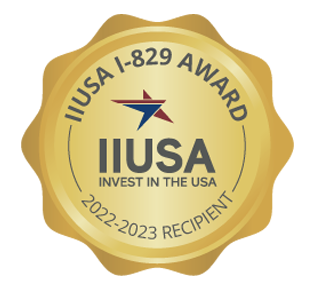EB-5 Visa Investment Options:
Direct vs. Through a Regional Center
The article discusses the differences between a direct EB-5 petition and a regional center EB-5 petition. The content below is for informational purposes only and does not constitute legal or financial advice.
In the article, you can find information about the following topics:
- What is a direct EB-5 visa?
- The costs of a direct EB-5 visa
- How to prepare for a direct filing?
- Regional center EB-5 visas
- What is a regional center?
- How to prepare an EB-5 visa application through a regional center
- Key differences between a direct EB-5 petition and an EB-5 petition through a regional center
What is an EB-5 visa?
The EB-5 Program was established in 1990 by the U.S. Congress. The primary objective of the EB-5 Program is to create jobs and promote economic development in designated targeted employment areas (also known as TEAs) or rural areas. It has gained popularity over the years as it offers a direct pathway to U.S. permanent residence (green card) and subsequently, an opportunity to apply for U.S. citizenship. The EB-5 Program provides green cards to the entire family simultaneously, including the investor, the spouse, and unmarried children under 21 years old. To qualify, a minimum investment of $800,000 in a TEA and $1,050,000 in non-TEA is required, along with documentation demonstrating the legal and traceable source of their investment funds. Moreover, investors are required to ensure that their investment leads to the creation or preservation of at least 10 permanent full-time jobs for qualifying U.S. workers within the time limits defined by the United States Citizenship and Immigration Services (USCIS). To learn more basic information about the EB-5 Program, please read the article.
What is a direct EB-5 visa?
A direct EB-5 visa, also referred as a "standalone" or "non-regional center" EB-5 visa, entails an immigrant investor making a direct investment and taking an active role in managing either a new commercial enterprise or an existing business that has been restructured or expanded to create or preserve 10 or more jobs, as required by the EB-5 Program.
Before filing a petition with the USCIS, it is essential to establish an entity, which could take the form of a limited liability company (LLC), C-Corporation (C-Corp), S-Corporation (S-Corp), or other suitable business forms.
Investment requirements
An entity requires a minimum investment of $800,000 in a TEA which is usually an area of high unemployment or a rural area. If the business is not located in a TEA, the investment amount required becomes $1,050,000.
A physical place of business is needed, and the address is shared with USCIS to determine whether it qualifies as a TEA or not. Office expenses include not only leasing costs but also additional expenses like utilities, computers, etc.
Job creation criteria
According to the EB-5 Program requirements, to be eligible for a petition, an investor must create 10 new positions, which entails hiring 10 new full-time American workers within a reasonable timeframe. While a business can start with 2 or 3 employees and gradually increase to 10 over the next couple of years, all workers must be new employees. Therefore, if acquiring an existing business, 10 additional new American workers (U.S. citizens or green card holders) must be added to the workforce. If an investor is starting a new business, 10 new American workers need to be added to the workforce, and the applicable positions should be full-time. USCIS defines ‘full-time’ as a minimum of 35 hours a week. Additionally, it is crucial to sustain these positions until receiving an unconditional green card. Each W-2 employee triggers additional expenses outside of the salaries, including payroll taxes, employee benefits, health insurance, etc.
Business plan verification
In addition to investment and job creation, a compliant business plan is necessary. It must detail how funds will be used, demonstrate business viability with market research, provide a financial plan for the next five years, and outline job creation. The business plan should have an organization chart, which clarifies which position in the company is held by the EB-5 investor and the reporting employees. The business plan should be professionally prepared and presented in a manner acceptable to USCIS.
Additional costs – Petition Filing
As a direct investor under the EB-5 Program, the investor would need to plan additional costs set aside from investment funds, which will cover not only immigration but also business requirements. These may include fees for an employment attorney, immigration attorney, corporate attorney, tax consultant, and CPA.
Juggling with immigration and business goals and associated risks
To be able to receive an EB-5 visa via direct investment, the investor need not only create and/or run a business but also to meet all EB-5 Program criteria for the required timeframe, even if it is not needed for business purposes.
Therefore, if the investor is pursuing a direct EB-5 investment in a qualified area, the minimum investment amount is $800,000. However, there is no cap on the total amount of the investment required to make the business feasible while meeting USCIS criteria. If the investor’s business is successful, it can generate revenue. Conversely, if not, the investor may be required to spend money to maintain compliance with immigration requirements for years.
What is a Regional Center EB-5 visa?
An EB-5 visa application via a qualified Regional Center, also referred as the "Regional Center Program" within the EB-5 Immigrant Investor Program, is the other option a prospective immigrant investor may choose. Unlike the direct EB-5 route, where immigrant investors directly invest and manage a new commercial enterprise, the Regional Center Program allows investors to indirectly invest in projects through the regional centers approved by USCIS.
What do regional centers do?
A regional center is a legal entity approved by USCIS to pool and invest immigrant investor capital in qualified EB-5 projects. As regional centers are required to structure, monitor and facilitate EB-5 offerings, the investment process requires significantly less involvement from the EB-5 investors. An investor does not need to proactively create employment and manage the immigration process because regional centers typically handle these aspects in line with the applicable laws and regulations. A regional center selects projects for investment that meet the USCIS requirements.
A regional center conducts financial and legal (securities, transactional and immigration) due diligence. To structure a compliant EB-5 offering, the regional center typically retains professionals to assess and confirm job creation potential, external attorneys to prepare compliant offering documents, and fund administrator to monitor the movement of the invested funds. The regional center also performs ongoing oversight on the projects, ensuring funds are appropriately spent according to the business plan, and provides quarterly updates to EB-5 investors.
Another significant advantage of an EB-5 application through a regional center is that investments can be pooled from multiple EB-5 investors in one project, providing additional capital protection and a passive process for the EB-5 investors.
Investment requirements
In addition to the $800,000 minimum investment, regional centers charge administrative fees typically ranging from $50,000 to $80,000. These fees cover additional services provided by the regional center and the costs of additional professionals (such as external attorneys, economists, business plan writers, fund administrators etc.) involved. Additionally, an EB-5 investor needs to retain a reputable EB-5 immigration attorney. The immigration attorney will assist the investor in documenting the source and path of funds, and will conduct immigration-specific due diligence on the EB-5 project.
Differences between a direct EB-5 visa and an EB-5 visa through a regional center
Today, over 90 percent of EB-5 investors choose an EB-5 petition through a regional center. There are multiple reasons for such a decision.
The level of investors’ involvement – Active vs. Passive
The most significant difference between the direct EB-5 approach and the EB-5 petition through a qualified regional center is the investor's level of involvement.
Direct EB-5 is a very hands-on process for the investor. Investors are required to hire multiple professionals, such as tax consultants, employment attorneys, immigration attorneys, corporate attorneys, and business plan experts, to prepare and file a petition approved by the USCIS. Direct EB-5 requires the investor’s active and deep involvement not only in the immigration process but also in the business operations.
In contrast, in the regional center approach, the heavy lifting is done by the regional center’s professionals. It is a hands-off approach, with the regional center taking care of the majority of the tasks. Investors simply need to retain a competent EB-5 immigration attorney who will assist them with documenting the source and path of funds and conducting immigration due diligence on the project.
In the case of direct EB-5, investors have control over their money. Thus, their success depends on their ability to manage both their finances and their business effectively. However, complications when investors venture into business fields in the US, with which they are likely not familiar, or try to manage the business remotely.
Conversely, with a regional center, experienced and dedicated regional center staff oversees investors’ funds, with the assistance of independent and competent professionals (e.g., external attorneys, economists, business plan writers, third-party fund administrators, tax consultants, etc.). These individuals specialize in managing capital and ensure thorough oversight and monitoring of the investment.
Equity vs. Debt
The main difference lies in the form of investment: equity in the direct approach and a loan in the regional center approach. In a regional center model, typically, investors’ funds are directed into projects, such as real estate developments, in the form of a loan for 3-5 years. A majority of the EB-5 investments are structured as mezzanine debt, which holds seniority over the equity position. In other words, regional center investor funds are typically in a more senior and secure position in a project’s capital stack, compared to the common equity position in a self-managed (direct) EB-5 project.
Regional centers work with developers to facilitate repayment of the invested funds to investors, along with any accrued interest. In contrast, in the direct EB-5 model, investors invest their capital as equity, solely dependent on their business performance.
Investment amount
As mentioned earlier, pursuing a direct EB-5 approach may entail ongoing costs without any spending cap until the investor obtains a green card. In a regional center sponsored EB-5 offering, the investor’s costs are fully disclosed and capped.
Job creation requirements
Job creation requirements vary between direct EB-5 projects and those spomsored by a regional centers. In a direct EB-5 project, investors must create 10 direct full-time American jobs. These employees must work directly for the investor’s business, with the investor responsible for payroll taxes, employee benefits, and insurance.
Conversely, in the regional center context, particularly in real estate projects, the job creation methodology is more flexible. In addition to counting jobs directly created through the project, such as construction jobs, indirect and induced job creation is also permissible through approved economic models based on construction spending. As a result, regional center sponsored EB-5 projects often exceed the required job creation threshold.
For a Free Consultation with an Experienced EB-5 Professional Enter your Details
Disclaimer
The opinions expressed in this video/blog post are solely those of the presenter/author. The information provided herein is for general informational purposes only and should not be considered as professional or legal advice. The presenter/author or Golden Gate Global do not endorse or take responsibility for any actions taken based on the information presented herein. Viewers/readers are advised to seek appropriate professional advice before making any decisions or taking any actions based on the content of this video/blog post.


